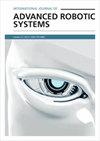Real-time marine target recognition method of underwater inspection robot based on computer vision
IF 2.1
4区 计算机科学
Q2 Computer Science
International Journal of Advanced Robotic Systems
Pub Date : 2023-09-01
DOI:10.1177/17298806231199845
引用次数: 0
Abstract
In the complex marine environment, target recognition is difficult, and the real-time detection has a slow speed. In this article, a target recognition method combining underwater generative adversarial network and improved YOLOv4 is proposed, which is named M-YOLOv4. Firstly, the images collected by the underwater inspection robot are enhanced using the underwater generative adversarial network algorithm to obtain the training datasets. Secondly, the YOLOv4 target detection algorithm combines the feature extraction network of MoblieNetv3 for lightweight processing, which reduces the network model size, and reduces the number of algorithm calculations and parameters. Then, change the size of the spatial pyramid pooling module pooling kernel, which can enlarge receptive field and integrate characteristics of different receptive fields. Finally, the processed datasets are transferred to the improved M-YOLOv4 algorithm for training, and the trained model is transplanted to the Jetson Nano hardware device for real-time detection. The results of experiments show that the mean average precision value of the improved M-YOLOv4 recognition is 90.77%, which is 2.02% higher than that of the unimproved one. The frame per second value of the lightweight YOLOv4 algorithm with MobileNetv3 is 27, an increase of 12 compared with YOLOv4. The improved M-YOLOv4 algorithm can perform accurate detection of marine multi-targets on embedded devices.基于计算机视觉的水下巡检机器人海洋目标实时识别方法
在复杂的海洋环境中,目标识别困难,实时检测速度慢。本文提出了一种水下生成对抗网络与改进的YOLOv4相结合的目标识别方法,命名为M-YOLOv4。首先,利用水下生成对抗网络算法对水下检测机器人采集的图像进行增强,得到训练数据集;其次,YOLOv4目标检测算法结合MoblieNetv3的特征提取网络进行轻量化处理,减小了网络模型的大小,减少了算法的计算量和参数。然后,改变空间金字塔池化模块池化核的大小,可以扩大感受野,整合不同感受野的特征。最后,将处理后的数据集转移到改进的M-YOLOv4算法中进行训练,并将训练好的模型移植到Jetson Nano硬件设备中进行实时检测。实验结果表明,改进后的M-YOLOv4识别平均精度为90.77%,比未改进的M-YOLOv4识别精度提高了2.02%。使用MobileNetv3的轻量级YOLOv4算法的帧/秒值为27,比YOLOv4增加了12。改进的M-YOLOv4算法可以对嵌入式设备上的海洋多目标进行精确检测。
本文章由计算机程序翻译,如有差异,请以英文原文为准。
求助全文
约1分钟内获得全文
求助全文
来源期刊
CiteScore
6.50
自引率
0.00%
发文量
65
审稿时长
6 months
期刊介绍:
International Journal of Advanced Robotic Systems (IJARS) is a JCR ranked, peer-reviewed open access journal covering the full spectrum of robotics research. The journal is addressed to both practicing professionals and researchers in the field of robotics and its specialty areas. IJARS features fourteen topic areas each headed by a Topic Editor-in-Chief, integrating all aspects of research in robotics under the journal''s domain.

 求助内容:
求助内容: 应助结果提醒方式:
应助结果提醒方式:


